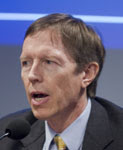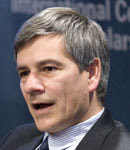Showing posts from category security.
-
Weekly Reading
›Conflicts among pastoralists over water and land have increased in drought-stricken northeastern Kenya, reports IRIN News.
Country for Sale, a report by Global Witness, alleges that Cambodia’s oil, gas, and mineral industries are highly corrupt.
Foreign Policy features an interview with General William “Kip” Ward, the commander of the new U.S. Africa Command. The New Security Beat covered General Ward’s recent comments on civilian-military cooperation.
Healthy Familes, Healthy Forests: Improving Human Health and Biodiversity Conservation details Conservation International’s integrated population-health-environment projects in Cambodia, Madagascar, and the Philippines.
Double Jeopardy: What the Climate Crisis Means for the Poor, a new report on climate change and poverty alleviation, synthesizes insights from an August 2008 roundtable convened by Richard C. Blum and the Brookings Institution’s Global Economy and Development Program at the Aspen Institute.
“Although the long-term implications of climate change and the retreating ice cap in the Arctic are still unclear, what is very clear is that the High North is going to require even more of the Alliance’s attention in the coming years,” said NATO Secretary General Jaap de Hoop Scheffer at a seminar on security prospects in the High North hosted by the Icelandic government in Reykjavik.
“I think we will work our way towards a position that says that having more than two children is irresponsible. It is the ghost at the table. We have all these big issues that everybody is looking at and then you don’t really hear anyone say the “p” word,” says UK Sustainable Development Commission Chair Jonathon Porrit, speaking about population’s impact on the environment. Porrit has drawn criticism for his remarks.
A local priest has warned that a Norwegian company’s proposed nickel mines will threaten food security on the Philippine island of Mindoro. -
VIDEO: Kent Butts on Climate Change, Security, and the U.S. Military
›February 5, 2009 // By Wilson Center Staff“Climate change is an important issue that can be addressed by all three elements of the national security equation: defense, diplomacy, and development,” says Kent Butts, in this short expert analysis from the Environmental Change and Security Program. Kent Butts, professor of political-military strategy at the Center for Strategic Leadership, U.S. Army War College, makes the case for considering global climate change a nontraditional threat to security and discusses how the U.S. military is reacting to a changing climate.
-
Developed World’s Dominance Declines with Age, Say Demographers
›February 5, 2009 // By Will Rogers “The whole world is aging, and the developed countries are leading the way,” said Neil Howe of the Center for Strategic and International Studies (CSIS) at a January 27, 2009, Wilson Center discussion of his latest report, The Graying of the Great Powers: Demography and Geopolitics in the 21st Century. Demography is as close as social science comes to predicting the future, Howe explained, presenting the geopolitical consequences of demographic trends over the next 50 years. Howe and co-author Richard Jackson, also of CSIS, were joined by Jennifer Sciubba of Rhodes College, who urged them and other demographers to explore how population trends interact with additional variables, such as environmental degradation, economic recession, and conflict.
“The whole world is aging, and the developed countries are leading the way,” said Neil Howe of the Center for Strategic and International Studies (CSIS) at a January 27, 2009, Wilson Center discussion of his latest report, The Graying of the Great Powers: Demography and Geopolitics in the 21st Century. Demography is as close as social science comes to predicting the future, Howe explained, presenting the geopolitical consequences of demographic trends over the next 50 years. Howe and co-author Richard Jackson, also of CSIS, were joined by Jennifer Sciubba of Rhodes College, who urged them and other demographers to explore how population trends interact with additional variables, such as environmental degradation, economic recession, and conflict.
Danger: Demographic Decline Approaching
“Populations in most developed countries will not only age, but stagnate or decline,” due to falling fertility and rising longevity, said Howe. Without “sizable immigration,” he warned, the populations of countries like the United States, France, Great Britain, Canada, Germany, and Japan will decline. As developed countries’ populations shrink, they will lose military might, savings and investment, entrepreneurship, and cultural influence. “Voltaire once said that God is on the side of biggest battalions,” Howe reminded the audience.
Developing Toward Greater Peace Jackson explained that the developing world is in the midst of the “demographic transition”—the drops in mortality and fertility that generally accompany economic and social development. Since 1970, the developing world’s overall fertility rate has declined from 5.1 to 2.9 children per woman, and its overall population growth rate has dropped from 2.2 percent to 1.3 percent per year, according to Jackson. Additionally, the median age has risen from 20 to 26 years old, “a cause for hope and optimism about the future,” Jackson argued, as countries with more balanced population age structures tend to be more democratic, prosperous, and peaceful than countries with extremely young ones.
Jackson explained that the developing world is in the midst of the “demographic transition”—the drops in mortality and fertility that generally accompany economic and social development. Since 1970, the developing world’s overall fertility rate has declined from 5.1 to 2.9 children per woman, and its overall population growth rate has dropped from 2.2 percent to 1.3 percent per year, according to Jackson. Additionally, the median age has risen from 20 to 26 years old, “a cause for hope and optimism about the future,” Jackson argued, as countries with more balanced population age structures tend to be more democratic, prosperous, and peaceful than countries with extremely young ones.
But despite the long-term possibility of a world transitioning toward greater peace and prosperity, the developing world will still experience near-term shocks. The timing and pace of the demographic transition varies widely by country and region, with some countries transitioning too fast or too far, said Jackson. These trends could push developing countries toward social collapse by acting “as a kind of multiplier on all the stresses of development,” explained Jackson—for instance, causing China “to lurch even more toward neo-authoritarianism.”
Crisis of the 2020s
Global demographic trends will converge in the 2020s to make that decade “very challenging,” said Howe. The developed world will undergo hyper-aging, population decline, and flattening GDP growth, along with rising pension and health care costs, Jackson noted. The Muslim world will experience a decade of temporary youth bulges, as the large generation that was born between 1990 and 2000 has children. The populations of Russia and Eastern Europe will implode, and Russia’s geopolitical strength and influence will wane. Meanwhile, China will experience a decade of “premature aging”; due to its one-child policy, it will become “gray” before it achieves the per capita GDP of most aging countries.
Demography and Public Policy Sciubba praised the report’s comprehensive, policy-friendly approach to demography, but urged the authors to remain true to the nuances of their topic, even in their conclusions and recommendations. “Policymakers like to know what we don’t know and what we do know. And with population aging and national security, often there’s a lot more of what we don’t know than what we do know,” she said. “Going into the future, we need more of an emphasis on places where policymakers can make a difference,” said Sciubba. “Opportunities matter just as much as challenges.”
Sciubba praised the report’s comprehensive, policy-friendly approach to demography, but urged the authors to remain true to the nuances of their topic, even in their conclusions and recommendations. “Policymakers like to know what we don’t know and what we do know. And with population aging and national security, often there’s a lot more of what we don’t know than what we do know,” she said. “Going into the future, we need more of an emphasis on places where policymakers can make a difference,” said Sciubba. “Opportunities matter just as much as challenges.”Photos: Neil Howe, Richard Jackson, and Jennifer Dabbs Sciubba. Courtesy of Dave Hawxhurst and the Wilson Center.
-
Weekly Reading
›The Feeding of the Nine Billion: Global Food Security for the 21st Century, a report from Chatham House, puts forth 10 proposals designed to make the global food system more resilient, sustainable, and equitable.
Strategic Implications of Global Health, a recent report from the National Intelligence Council, builds on a 2000 National Intelligence Estimate analyzing the links between global health and U.S. national security, but places more emphasis on non-infectious issues like maternal mortality, malnutrition, and chronic diseases.
Bill Gates’ first annual letter about his work at the Gates Foundation includes a chart showing that better overall health is linked to smaller families.
“How Much Would You Pay to Save the Planet? The American Press and the Economics of Climate Change,” a discussion paper from Harvard University’s Joan Shorenstein Center on the Press, Politics, and Public Policy, examines coverage of the economic debate over the Lieberman-Warner Climate Security Act of 2008.
Population Connection’s February 2009 Reporter features stories on Ghana’s slow progress on reproductive health and Thomas Friedman’s book Hot, Flat, and Crowded, among others.
The Economist examines the connections between failed states and conflict, terrorism, poverty, and disease. Failed states were a major concern of the recent U.S. National Defense Strategy. -
VIDEO: Christian Leuprecht on Demography, Conflict, and National Security
›January 29, 2009 // By Wilson Center Staff“Demographics are going to be to the 21st century what class cleavages were to the 19th century,” says Christian Leuprecht in this short expert analysis from the Environmental Change and Security Program. In this video, Leuprecht, an assistant professor at the Royal Military College of Canada, makes the case for the importance of demographic dynamics and their connections to conflict and security. -
Head of AFRICOM Discusses Civilian-Military Cooperation
›January 28, 2009 // By Rachel Weisshaar Critics have warned that the new unified U.S. Africa Command (AFRICOM) could threaten the sovereignty of African nations and encroach on the portfolios of other U.S. agencies like the U.S. Agency for International Development (USAID). But in an interview with USAID newsletter FrontLines, General William E. “Kip” Ward, head of AFRICOM, went out of his way to dispel these fears. Some of the most interesting parts of the interview:
Critics have warned that the new unified U.S. Africa Command (AFRICOM) could threaten the sovereignty of African nations and encroach on the portfolios of other U.S. agencies like the U.S. Agency for International Development (USAID). But in an interview with USAID newsletter FrontLines, General William E. “Kip” Ward, head of AFRICOM, went out of his way to dispel these fears. Some of the most interesting parts of the interview:
On AFRICOM’s humanitarian efforts:
“We know that our piece is only a very small part of the totality of humanitarian assistance that’s being performed by USAID and other agencies. We would not look to take those roles over.”
On civilian-military cooperation:
“We are learning to understand one another better and truly, as [USAID] Administrator [Henrietta] Fore and [Defense] Secretary [Robert] Gates said, we are seeing with greater clarity the importance of all these efforts working as cohesively together as they can. Security and development go hand-in-hand to produce stability that we all seek.”
On coordinating with USAID and host countries:
“We would get involved where those development projects complemented the work being done by developmental agencies, USAID, in very close coordination with the country team, the ambassador, and representatives from USAID that are there on the ground. We want to ensure that we don’t do things that conflict with the work being done by others. This might include a school being built so we can complement each other’s efforts. Or, at the request of a country, we might conduct an exercise and we may need to build a road to get to a training area. And if building the road in one place or another could help the population, then we would look to work with the country team and the ambassador so it provides benefits to the population.”
Photo: Comoran Defense Chief of Staff Salimou Mohamed Amiri (left) talks with General William E. Ward, commander of U.S. Africa Command (right), on January 21, 2009. Ward met with Comoran government officials as part of his first official visit to the island nation. Courtesy of by Kenneth Fidler, U.S. Africa Command. -
Population, Family Planning Experts Urge Obama to Make Billion-Plus Investment
›January 22, 2009 // By Rachel WeisshaarFamily planning experts and advocates have wasted no time urging President Barack Obama to reverse former President George W. Bush’s international family planning policies. Five former directors of population and reproductive health at the U.S. Agency for International Development (USAID) call for the United States to renew its political and financial commitment to global family planning programs in Making the Case for U.S. International Family Planning Assistance, a report by the Population Reference Bureau (PRB). The former bureaucrats recommend that USAID’s budget for international family planning be increased to $1.2 billion in FY 2010, up from $457 million in FY 2008, and that it be raised gradually to $1.5 billion in FY 2014 in order to achieve the Millennium Development Goal of universal access to reproductive health services by 2015.
In a compelling white paper (executive summary) submitted to the Obama transition team by Population Action International (PAI), the authors argue that by investing in voluntary family planning, the United States can “foster more peaceful, stable societies and improve maternal and child health, reduce unintended pregnancies and abortion, lower HIV infection rates, reduce poverty, enhance girls’ education, decrease hunger, and slow the depletion of natural resources.” PAI asks President Obama to:- Increase total U.S. FY 2010 spending on family planning and reproductive health to $1 billion;
- Rescind the Global Gag Rule/Mexico City Policy;
- Restore U.S. funding to the UN Population Fund; and
- Increase funding for programs to reduce maternal and child mortality, prevent the spread of sexually transmitted diseases, and improve the status of women.
-
Man vs. Wildlife: Now Playing in Southeast Asia
›January 22, 2009 // By Will Rogers“There are no winners when elephants and humans compete for the same resources,” writes Amirtharaj Christy Williams, a biologist with the World Wildlife Federation (WWF), in the BBC’s Green Room. As urban sprawl and deforestation across Southeast Asia shrink elephants’ natural habitat, they are increasingly forced to compete with humans for access to freshwater and vegetation. And when elephants and humans compete for natural resources, elephants are no match for the “destructive power of humans.”
According to Williams, elephants need roughly 200 square kilometers of forest to roam. When their habitats become fragmented by roads, canals, dams, and mines—as in Nepal, India, and Bangladesh—or are destroyed to create palm oil, coffee, tea, and other plantations—as in Indonesia—they cross roads and trample through fields with awesome destructive power, sometimes taking human lives in their search for food and water. Angered and frightened, the villagers, “lacking technical help and access to effective and humane mitigation methods, retaliate by throwing burning tyres, shooting at the beasts with sharpened nails, even by laying out foods laced with killer pesticides,” Williams writes.
But it would be too easy to blame people for their destructive reaction to the elephants. “Imagine the psychological impact of elephant raids on villagers living in fragile mud and bamboo huts,” and the subsequent loss of a loved one, and you can begin to understand the human side of this conflict, Williams observes.
To be sure, those in illegal settlements and plantations in protected parks are partly to blame for encroaching on elephant habitat with little regard for the consequences. According to an October 2007 WWF report, Gone in an Instant, Indonesia’s illegal Sumatran coffee plantations were responsible for a decline in the elephant population in the Bukit Barisan Selatan National Park (BBSNP) between 2000 and 2004. The report found that 45 “problem” elephants were killed in the BBSNP during that time as a result of human-elephant conflict. Most alarmingly, the report discovered that the conflict between illegal coffee farmers and wildlife was not limited to elephants, but that the Sumatran rhino and tiger—both listed as critically endangered by the International Union for the Conservation of Nature—were also victims of human displacement and poaching.
At the same time, “more wholesale damage is caused by sanctioned habitat clearing at the hands of short-sighted government officials who encourage large areas to be set aside for monoculture cash-crop plantations or infrastructural and development projects” than by the retaliatory acts of villagers and farmers, Williams argues. Environmental impact assessments written by corrupt officials and narrow-minded politicians with their own interests in mind often neglect elephants (and other species) altogether. The sad truth is that “elephants are virtually led to the slaughter by the very governments mandated to protect them.”
Yet solutions to human-wildlife conflict do exist. “Sharing the Forest: Protecting Gorillas and Helping Families in Uganda,” outlines how a holistic approach—encompassing environmental conservation, family planning, basic health care, and support for alternative livelihoods—can lessen human-wildlife conflict. It is possible to reduce the rate of human-wildlife conflict—while boosting endangered species’ populations and helping communities escape poverty—but it takes creativity, patience, and a comprehensive approach.
Photo: Elephants in the wild near Habarana, Sri Lanka. Across East and Southeast Asia, urban sprawl and deforestation threaten wild elephants by displacing them from their natural habitats, forcing them to compete with humans for access to vital natural resources. Courtesy of flickr user Jungle Boy.


 “The whole world is aging, and the developed countries are leading the way,” said Neil Howe of the Center for Strategic and International Studies (CSIS) at a January 27, 2009,
“The whole world is aging, and the developed countries are leading the way,” said Neil Howe of the Center for Strategic and International Studies (CSIS) at a January 27, 2009,  Jackson explained that the developing world is in the midst of the “demographic transition”—the drops in mortality and fertility that generally accompany economic and social development. Since 1970, the developing world’s overall fertility rate has declined from 5.1 to 2.9 children per woman, and its overall population growth rate has dropped from 2.2 percent to 1.3 percent per year, according to Jackson. Additionally, the median age has risen from 20 to 26 years old, “a cause for hope and optimism about the future,” Jackson argued, as countries with more balanced population age structures tend to be
Jackson explained that the developing world is in the midst of the “demographic transition”—the drops in mortality and fertility that generally accompany economic and social development. Since 1970, the developing world’s overall fertility rate has declined from 5.1 to 2.9 children per woman, and its overall population growth rate has dropped from 2.2 percent to 1.3 percent per year, according to Jackson. Additionally, the median age has risen from 20 to 26 years old, “a cause for hope and optimism about the future,” Jackson argued, as countries with more balanced population age structures tend to be  Sciubba praised the report’s comprehensive, policy-friendly approach to demography, but urged the authors to remain true to the nuances of their topic, even in their conclusions and recommendations. “Policymakers like to know what we don’t know and what we do know. And with population aging and national security, often there’s a lot more of what we don’t know than what we do know,” she said. “Going into the future, we need more of an emphasis on places where policymakers can make a difference,” said Sciubba. “Opportunities matter just as much as challenges.”
Sciubba praised the report’s comprehensive, policy-friendly approach to demography, but urged the authors to remain true to the nuances of their topic, even in their conclusions and recommendations. “Policymakers like to know what we don’t know and what we do know. And with population aging and national security, often there’s a lot more of what we don’t know than what we do know,” she said. “Going into the future, we need more of an emphasis on places where policymakers can make a difference,” said Sciubba. “Opportunities matter just as much as challenges.” Critics have warned that the new unified U.S. Africa Command (
Critics have warned that the new unified U.S. Africa Command (


